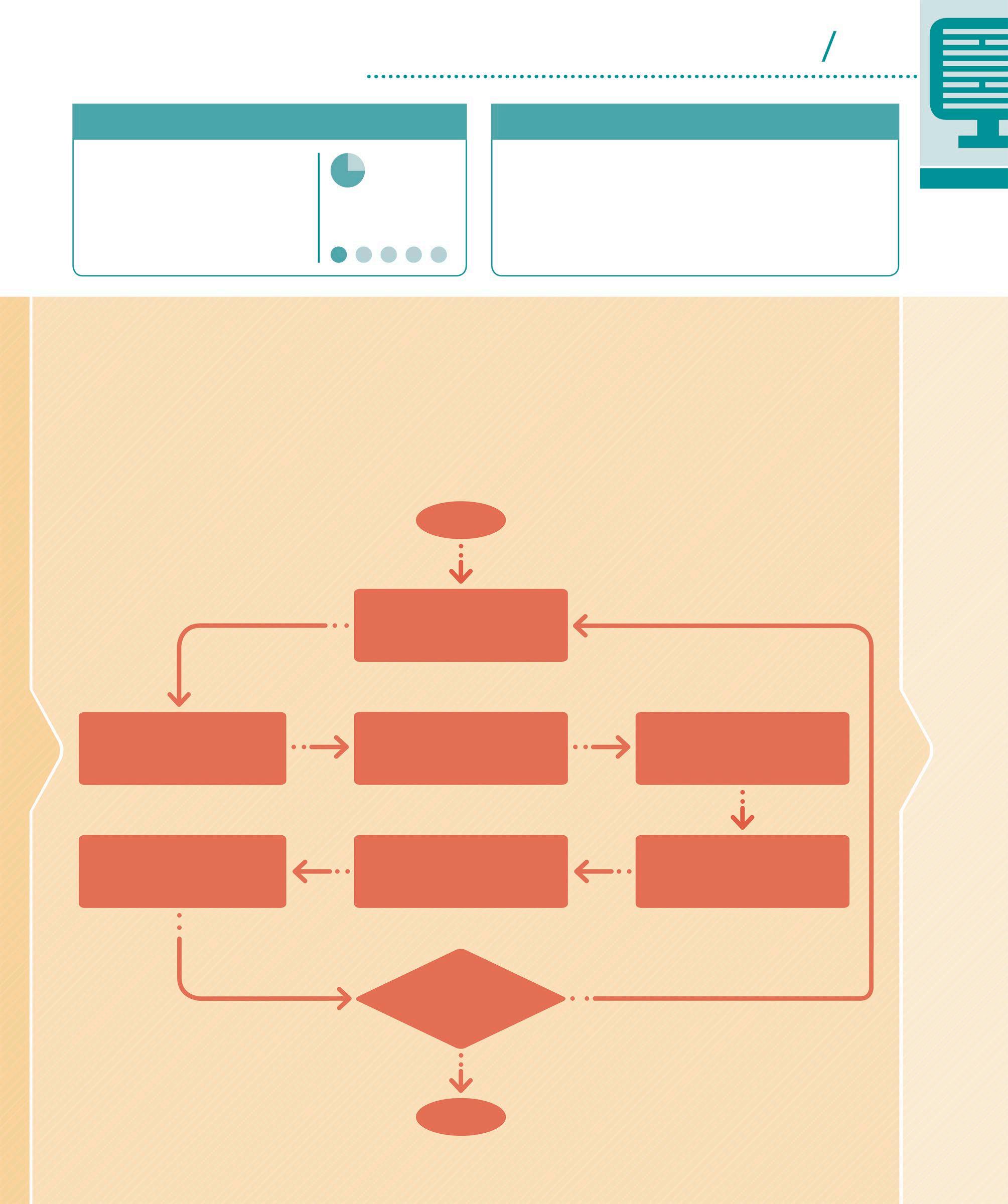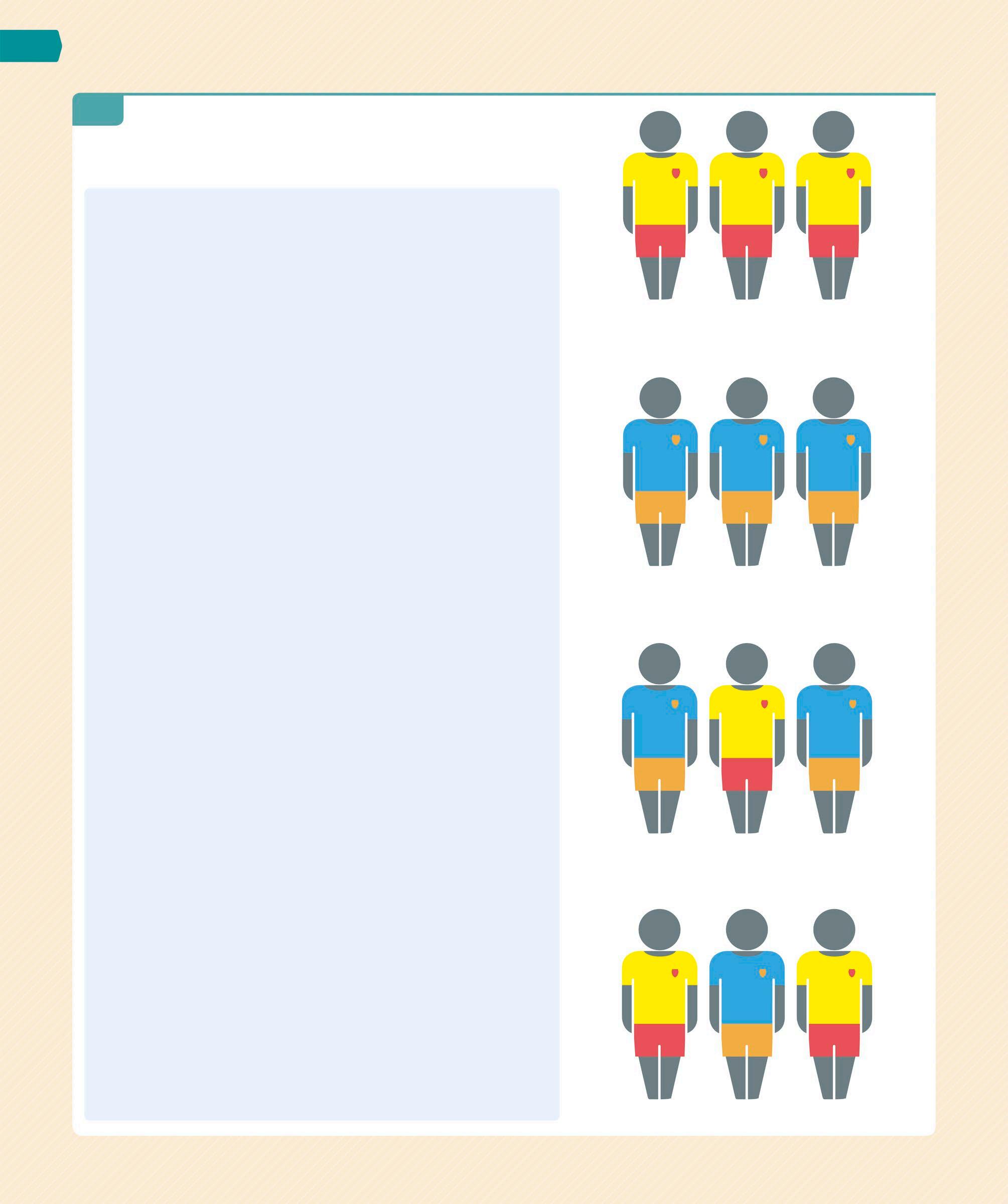14 minute read
PROJECT: Team allocator
Team allocator
When playing team sports, the first thing you have to do is to pick the teams. One way of doing this is to choose team captains and let them choose the players for their teams. However, it might be fairer to pick people randomly. In this project, you’ll automate this process by building a tool in Python that picks teams randomly.
How it works
This project will use Python’s random module to form teams, with randomly selected players. You will use lists (see p.103) to store the player’s names. The random module will then shuffle this list into a different order. Loops will be used to iterate through the list and display the players. Finally, an if statement (see p.105) checks to see if the user is happy with the selection.
Random allocation
This project will pick two teams and a captain for each team. When you run the program, it will display the chosen teams and captains on the screen.
Python 3.7.0 shell
Welcome to Team Allocator!
Team 1 captain: Rose Team 1:
Jean
Ada
Sue
Claire
Martin
Harry Alice
Craig Rose
James
The list of players is displayed in the shell window
YOU WILL LEARN
❯ How to use the random module ❯ How to use lists ❯ How to use loops ❯ How to use branching statements
Time:
15–20 mins
Lines of code: 24
Difficulty level
WHERE THIS IS USED
The code in this project can be reused for tasks that require random allocations. This includes staff shift scheduling, assigning tasks in the workplace, matching people to projects, selecting teams for a quiz, and many more. This can be a quick and fair way of allocating people to teams/tasks.
Program design
The program begins by shuffling the player list. It then allocates the first half as Team 1, randomly selects a captain, and displays the name of the captain along with the names of the rest of the team. The steps are then repeated for the second half of the list – forming Team 2. If you want to pick the teams again, the program repeats the steps, otherwise, the program ends.
START
Assign players from the first half of the player list to Team 1

Display captain and players for Team 2 Shuffle players
Randomly pick captain for Team 1
Randomly pick captain for Team 2
Pick again?
NO YES Display captain and players for Team 1
Assign players from the second half of the player list to Team 2
1 Create a team This program will simplify the process of picking, or allocating, teams. In this section, you will create the file that will contain the code, import a module, and then make a list of players.
1.1 CREATE A NEW FILE The first step is to open IDLE. A shell window will appear. Ignore it and click on File in the IDLE menu. Then, choose New File and save the file as “team_selector.py”. This will create an empty editor window where you can write your program. 1.2 ADD THE MODULE Now, import the random module. Type this line at the top of your file, so that you can use the module later. This module contains functions that will allow you to pick players randomly from a list.
File Edit Shell
New File N Open... O Open Module... Recent Files Module Browser B
Click here to create a new file The random module can pick random numbers or shuffle a list in a random order
This phrase will appear as the welcome message in the shell window
import random
1.3 WELCOME THE USER Next, create a message to welcome the user to the program. This will show a message to the user when the program executes. Save the file and then run the program to ensure your code works. From the Run menu, choose Run Module. If you have typed in the code successfully the welcome message should appear in the shell window.
print("Welcome to Team Allocator!")

Welcome to Team Allocator!
SAVE
WELCOME TO TEAM ALLOCATOR!
RANDOM NUMBERS
Random numbers can be used to simulate anything that can be random or is meant to be random. For example, rolling a dice, tossing a coin, or picking a card from a deck. Python’s random module helps add an element of chance to a program. You can read more about how to use this module in the Docs section of IDLE’s Help menu.
1 8 3 6 9
6 4 7 2
5
5
1.4 MAKE A NAME LIST You will need names for all the players to generate your teams randomly. In Python, you can keep groups of related items together in a list (see p.103). First, create the variable players to store the list by typing this new block of code below the import statement. Put the list contents in square brackets, and separate each item in the list with a comma.
import random players = ["Martin", "Craig", "Sue", "Claire", "Dave", "Alice", "Sonakshi", "Harry", "Jack", "Rose", "Lexi", "Maria", "Thomas", "James", "William", "Ada", "Grace", "Jean", "Marissa", "Alan"]
print("Welcome to Team Allocator!") random.shuffle(players)

This project has 20 players in the list. You can change the number of players if you like (see p. 127) The list is assigned to the variable players
You do not need to use a backslash (\) to split a list across two lines. Pressing return or Enter indents the next line in a list
Each item in the list is a string enclosed in quotation marks
1.5 SHUFFLE THE PLAYERS There are a few ways in which the players can be randomly selected. You could randomly keep picking players and assign them to the two teams until you run out of players. This program assumes the number of players is even. However, an even simpler way would be to just shuffle the list of players randomly and assign the first half of the list to “Team 1” and the second half to “Team 2”. To do this, the first thing you have to do is to shuffle the players. Use the shuffle() function from the random module. Type this code below the print command.
This will shuffle the list of players just like you would shuffle a deck of cards
2 Pick teams Now that the list of players is ready, you can split the players into two teams. You will then assign the team captains. The teams and the names of their captains will be displayed on screen when the program is executed.
SPLITTING LISTS
In Python, when splitting or taking subsets of a list you need to provide two arguments: the start index (position) and the index after the last item in the new list. Remember, indexes start from 0 in Python (see p.103). For example, players[1:3] would take the players from index 1 up to index 2. The first index is inclusive (it is included in the new list) and the second index is exclusive (it is included up to the item before it in the new list). If you are splitting the list from the first position up to the last position, then you can leave those indexes blank as Python will understand this. For example, players[:3] will take the first three players from the list and players[4:] will take the players from index 4 up to the end of the list.
2.1 SELECT THE FIRST TEAM You now need to split the list into two equal parts. To do this, take the items in the list from position 0 up to the last item in the list and divide it by two. Add the following code at the end of the file for welcoming the user. This will create a new list with the first half of the players list.
team1 = players[:len(players)//2]
This new list will be assigned to the variable team1
2.2 SELECT TEAM 1 CAPTAIN Once you have allocated the first team, you need to choose the team captain. To make it a fair selection, this will also be done randomly. A player from team1 will be picked and assigned to be the team captain. Use the choice() function to pick a player randomly from team1. Type this code at the end of the file. The captain is randomly selected from the team1 list using the choice() function and appended to the string to be displayed.

2.3 DISPLAY TEAM 1 After the captain is assigned, you need to display all the players from “Team 1” on screen. Remember you can use a for loop (see p.108) to iterate through a list. Type the following code at the end of the file.
print("Team 1 captain: " + random.choice(team1))
Prints the message stating who the team captain is
Prints a message to tell the user that the players for Team 1 are being displayed
print("Team 1:") for player in team1: print(player)
This loop iterates through team1 Prints the current player’s name
SAVE
2.4 TEST THE PROGRAM This is a good point to test your code. Run the code and look in the shell window to see the result. Does it display the players for Team 1? Does it display the number you expected? Is it randomly selecting a team captain that is actually part of Team 1? Run the code a few times to ensure it is random. If you have any errors, look back over your code carefully to spot any mistakes.
SELECT THE SECOND TEAM
Now you can allocate players for the second team by repeating steps 2.1–2.3. Type the following code at the end of the file.
C
Welcome to Team Allocator!
Team 1 captain: Claire Team 1:
Maria
Jean
William
Alice
Claire
Jack
Lexi
Craig James
Alan
2.5

Assigns the second half of the list to the variable team2. The players in this list will be part of the second team
team2 = players[len(players)//2:] print("\nTeam 2 captain: " + random.choice(team2)) print("Team 2:") for player in team2: print(player)
This loop iterates through team2 “\n” prints the name of the team captain for Team 2 on a new line
SAVE
2.6 TEST THE PROGRAM Run the code to test the program again. Ensure that it is working as expected for both teams. You should be able to see the list of players for both the teams along with the names of their captains.
Welcome to Team Allocator!

Team 1 captain: Marissa Team 1:
Harry Claire
Jack
Sue
Dave
Craig Marissa
Grace
Alan
Maria
Team 2 captain: James Team 2:
Martin
Jean
Alice
Ada
William
Rose
Lexi
James
Sonakshi
Thomas
The name of the captain will be displayed before the list of players
3 PICK NEW TEAMS
You can now use a while loop to keep selecting teams until you are happy with them. Add a new line of code below the welcome message and remember to add indents for all the lines of code following this new line, as shown below. This will ensure that the existing code is part of the while loop.
REDRAW PLAYERS
Finally, add the following code to ask users if they would like to pick teams again. Store the reply in a variable called response. If you choose to redraw the players, the main loop will run again and display the new teams.
print("Welcome to Team Selector!") while True:
random.shuffle(players) team1 = players[:len(players)//2] print("Team 1 captain: "+random.choice(team1)) print("Team 1:") for player in team1: print(player) team2 = players[:len(players)//2:] print("\n Team 2 captain: "+random.choice(team2)) print("Team 2:") for player in team2: print(player)

3.1
Displays a message to ask users if they would like to redraw the players Adds the loop that allows selecting the teams again
Add indents to these lines of code to make them part of the loop
response = input("Pick teams again? Type y or n: ") if response == "n": break
Breaks out of the main loop if the response is n
SAVE
3.2 RUN THE CODE The program is now ready. Test the program again. You will see the list of both teams with the team captains, and a message at the end asking if you would like to redraw the players.
Welcome to Team Allocator!
Team 1 captain: Rose Team 1:
Jean
Ada
James
Claire
Martin
Harry Alice
Craig Rose
Sonakshi
Team 2 captain: William Team 2:
Jack
Maria
Sue
Alan
Dave
Grace
Marissa
Lexi
Thomas
William
Pick teams again? Type y or n:

TEAM 1
TEAM 2
RESHUFFLED TEAM 1
Hacks and tweaks
Add more players
The program has a list of 20 names. To add more players to the team selector, try adding some more names to the list. Keep the total number of players even, so that the teams have equal numbers of players on them.
More teams
Different sports have different numbers of players in their teams. The code in this project assumes that there will be two teams. However, if you have a longer list of players, you can even have three or more teams. Update the code in the program to ask
EXTRA PLAYERS
the user for the number of players they want in each team. You can then split the number of players into the number of teams they can equally be split into. If a team is short of players, make sure to inform the user of this.
while True:
random.shuffle(players) team1 = players[:len(players)//3] print("Team 1 captain: " + random.choice(team1)) print("Team 1:") for player in team1: print(player) team2 = players[len(players)//3:(len(players)//3)*2] print("\nTeam 2 captain: " + random.choice(team2)) print("Team 2:") for player in team2: print(player) team3 = players[(len(players)//3)*2:] print("\nTeam 3 captain: " + random.choice(team2)) print("Team 3:") for player in team3: print(player)

Splits the number of players into three equal parts and assigns the first part of the players list to team1
Assigns the second part of the players list to team2
Assigns the third team with its own list of players and the team captain
Team or tournament
Currently the program assumes that the code is for a team sport. If you want to create a program for individual sports, change the code as shown below. This will ask the user if the players need to be split for an individual or team sport. If you pick team, the code should run as you have already tested. However, if you pick “individual”, the code will split the players into random pairs to play against each other.
print("Welcome to Team/Player Allocator!") while True:
random.shuffle(players) response = input("Is it a team or individual sport? \ \nType team or individual: ") if response == "team": team1 = players[:len(players)//2]
for player in team2: print(player) else:
for i in range(0, 20, 2): print(players[i] + " vs " + players[i+1])
Displays a message to ask the user if it is a team or an individual sport
Checks for the user’s response
Prints the name of players that will play against each other
The shell window displays who starts
Range will take the value 0-19 and will increment by 2 each time. This is so we go through the list two players at a time to put them in pairs

Who starts?
For both team and individual sports there is usually a method to determine who will go first. Add this extra code to the program from the previous hack to do this for individual sports.
JAMES print(players[i] + " vs " + players[i+1]) start = random.randrange(i, i+2) print(players[start] + " starts")
HARRY Welcome to Team/Player Selector! Is it a team or individual sport? Type team or individual: individual James vs Harry James starts
Change to list of numbers
The current program is only a good solution if you always play with the same people. However, if this is not the case, you can replace the player names with numbers to make it a more general solution. Remember to assign the numbers to the players before you use it.
import random
players = [1, 2, 3, 4, 5, 6, 7, 8, 9, 10, 11, 12, 13, 14, 15, 16, 17, 18, 19, 20]
print("Welcome to Team Allocator!")
Update the code to replace the names with numbers
Number of players
Instead of having to change the size of the list each time you have more or fewer players, you can update the code to ask the user for the total number of players. This will create the number list, as well as create two equal teams. Update the program as shown here.
import random players = [] print("Welcome to Team Allocator!") number_of_players = int(input("How many players \ are there? ")) for i in range(1, number_of_players + 1): players.append(i)

Displays a message for the user to enter the number of players
team1 = players[:len(players)//2] print("Team 1 captain: " + str(random.choice(team1)))
print("Team 1:") Updates code for team1
team2 = players[len(players)//2:] print("\nTeam 2 captain: " + str(random.choice(team2)))
print("Team 2:") Updates code for team2











